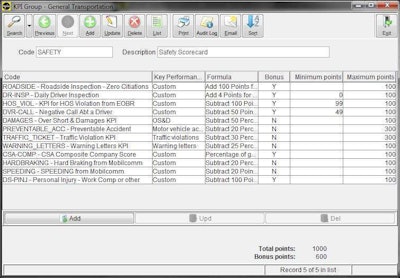One of the timely topics discussed at the Truckload Carriers Association’s annual conference, held in Grapevine, Texas, March 23-25, was creating incentive plans for drivers.
 Beth Carroll, managing principal of Prosperio Group
Beth Carroll, managing principal of Prosperio GroupBeth Carroll, managing principal of the Prosperio Group, presented a “Trucking in the Round” session on innovative methods for driver pay. Increasingly, she said, more fleets are creating pay-for-performance plans to motivate the new generation.
New incentive programs are less likely to gain traction among baby boomers and middle-age Generation X. Incentives come much more naturally to the younger drivers, Generation Y, whom Carroll called the “trophy generation” since they grew up expecting to be rewarded.
On the upside, younger workers are networked and “technology is wired into their genes,” she said. They may be tech savvy but they also present some challenges. When asked, fleet executives in the meeting said younger drivers want to be paid upfront for their job performance and be given immediate feedback.
Onboard monitoring systems do make it possible to give timely feedback. What the industry needs more of, she said, is “enterprise performance management systems” to streamline the administration and communication of incentive and rewards programs.
Before going into detail about how to create effective driver incentives, Carroll cautioned fleets to not overly emphasize the monetary component. Money, after all, is an external motivator. A more effective approach is to emphasize the intrinsic motivators like job mastery and purpose that give drivers satisfaction for doing what they already know to be a very difficult job.
“Make sure they (drivers) know they are contributing something to a small team, to the company and to the economy,” she said. “Build drivers up as much as you can and then put an external plan on top of it.” Otherwise an external motivator will feel like a bribe, or worse, a stick if you are taking something away.
Carroll then went through a seven-step process to explain how to create an effective driver pay-for-performance plan.
Define the results desired. Start by identifying the two or three things you want a new incentive compensation plan to fix. For instance, perhaps you want to find a way to give raises to only your top-performing drivers and to reduce costs. Once you have identified the desired results, determine the specific areas of performance that you will target for improvement such as fuel economy, CSA scores and utilization.
 McLeod Software’s Driver Scorecard module pulls data from a variety of sources
McLeod Software’s Driver Scorecard module pulls data from a variety of sourcesGather driver feedback. Understanding the culture of a company is necessary to build momentum towards a new compensation plan. Talk to drivers and collect information through surveys. Find out what incentives may already be sacred to your drivers such as a quarterly safety bonus. “Find out ahead of time what you can change and what you can’t,” she says.
Clarify driver types. Incentives cannot be the same for all of the driver population. Fleets have to set goals relative to each type of operation such as local, regional and over the road and by the type of equipment drivers are assigned to. “It is a constant challenge to get as close as applicable to an individual as you can but not create something that is complex to manage,” she said.
Set Total Target Cash (TTC), pay mix and weights. Total Target Cash is the foundation of an incentive plan; it is the actual “cash in the pocket” that drivers stand to receive. The formula for TTC is base pay plus incentives at 100 percent performance.
Next, choose the elements of the plan. An element is what is being measured and the relative emphasis or weight of each item is given. Examples of elements include utilization, fuel efficiency and on-time performance. The weight assigned to each element shows drivers what matters and in what order it matters.
Develop plan mechanics. For each element, establish the mechanics of how performance will be measured, the length of each measurement period, the frequency of the payouts, and how pay will be delivered (cash, points, rewards, etc.).
Common types of incentive plans include giving drivers a retroactive cost per mile increase (based on all miles driven during a period), a tiered incentive with a flat payout, and a prospective change to the base rate (based on future miles driven in the next period).
Carroll also discussed an incentive plan that is becoming more popular where drivers qualify for a reward in one period but then get paid in the next period through an increase, in the cents per mile, for miles they drive in period two.
“This is about the only industry I’ve seen where you have non-concurrent payouts. Typically you do the activity and get the reward,” she says. “I think there are a lot of valid reasons; it is a great retention tool, but things are not matched up. I may have a great quarter, but if the economy tanks and mileage is not as good, the driver is not getting the benefit.”
Carroll recommends that fleets split the reward so that part of the payout is concurrent and the other part is non-concurrent.
Fleets will typically include qualifiers for each element in an incentive plan. An example of a qualifier is to have a minimum mileage threshold or to disqualify drivers from the incentive if they have an accident during the measurement period.
Whatever the elements and mechanics may be, Carroll recommends that the incentive be about 10 percent of TTC. The midpoint, or median, of the driver population should be receiving the full 10 percent based on performance. Drivers that perform in the top 10 percent of the population should be making more, perhaps 50 percent more, in incentives. Overall, about 90 percent of the driver population should at least getting something, she says.
Model the new plans. Once the mechanics are in place, evaluate the economic impact of the plan by testing the model backwards and forwards against historical shipment or trip data to identify anomalies. Carroll recommended the use of data visualization products like Tableau to help communicate with drivers their earnings under the current compensation plan and within the new pay plan. Drivers want to know the answer to one question: “What is this going to do for me?”
Roll out the new plan. To ensure driver buy in and understanding test the new plan first with a small group of drivers to make sure your assumptions work, that you are able to communicate the plan and anticipate questions before rolling it out to the larger population.
Finally, Carroll says it is important to continually reinforce the plan to sustain momentum. It usually takes a few months before drivers “get the hang of it,” she says.
Many real-world examples of the types of incentive programs that Carroll spoke about can be found by clicking on the related articles in this post. In case you missed it, here is an in-depth look at a pay-for-performance program developed by Nussbaum Transportation.













